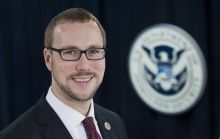DHS to elevate cyber integration center, names Ozment as director
Secretary Jeh Johnson is reorganizing the National Protection and Programs Directorate (NPPD) and elevating the role of the National Cybersecurity and...
The Homeland Security Department’s National Cybersecurity and Communications Integration Center has been without a permanent leader for almost a year. But a lot has changed in a year, so Secretary Jeh Johnson is turning internally for new leadership and elevating that role.
Johnson today announced Andy Ozment, the assistant secretary of the Office of Cybersecurity and Communications within the National Protection and Programs Directorate (NPPD), will oversee and direct the NCCIC.

DHS also announced John Felker would come back to the government to run the day-to-day operations of the NCCIC.
“Given the central importance of the NCCIC to the DHS cybersecurity mission, I have determined that we must elevate the NCCIC within our department’s structure, with an incident reporting line directly to me as Secretary,” Johnson said in an email statement. “Equally as important, I have also directed the National Protection and Programs Directorate (NPPD) to develop a reorganization plan that will ensure the NCCIC is focused on strengthening our operational capabilities for mitigating and responding to cyber incidents.”
Ozment replaces Larry Zelvin who retired last August after almost 30 years in government. Greg Touhill, the deputy assistant secretary for Cybersecurity Operations and Programs, has been the interim NCCIC director over the last year.
Johnson’s decision to elevate the NCCIC and reorganize the office isn’t surprising given the growing role it has in securing the dot-gov domain and working with the private sector to identify and combat cyber threats.
Lawmakers also have recognized the center’s increased value, introducing legislation to give DHS more authority over federal networks.
Johnson said in July at an event hosted by the Center for Strategic and International Studies (CSIS) that he expects the NCCIC to become even busier this fall. DHS automates the sharing of cyber-threat indicators. One agency has begun receiving information through the system a month ahead of schedule. Johnson said he expected “multiple” agencies, as well as companies that regularly work with NCCIC , to join in by October.
The center’s expected increased role in the federal community is part of the administration’s broader goal to better fund and resource these cyber efforts.
The White House issued an updated fact sheet about President Barack Obama’s fiscal 2016 cybersecurity budget request. DHS is asking for $1.4 billion, a 7 percent increase over 2015. Of that, $480 million would go to expand the EINSTEIN program and $102 million would be for the continuous diagnostics and mitigation (CDM) program, both of which are run out of NPPD.
Across the government, the Office of Management and Budget said the President’s requested $14 billion for cybersecurity next year. It would be an increase of $1.4 billion, or 11 percent, above the level provided in 2015.
Felker returns to DHS in some regards after spending most of his career in the Coast Guard, where he retired in 2012 as the deputy commander of the U.S. Coast Guard Cyber Command.
Since retiring after 30 years of service, Felker worked most recently as the director of cyber and intelligence strategy for HP Enterprise Services. He also was the vice president of cyber programs at SCI Consulting.
Copyright © 2025 Federal News Network. All rights reserved. This website is not intended for users located within the European Economic Area.
Jason Miller is executive editor of Federal News Network and directs news coverage on the people, policy and programs of the federal government.
Follow @jmillerWFED



